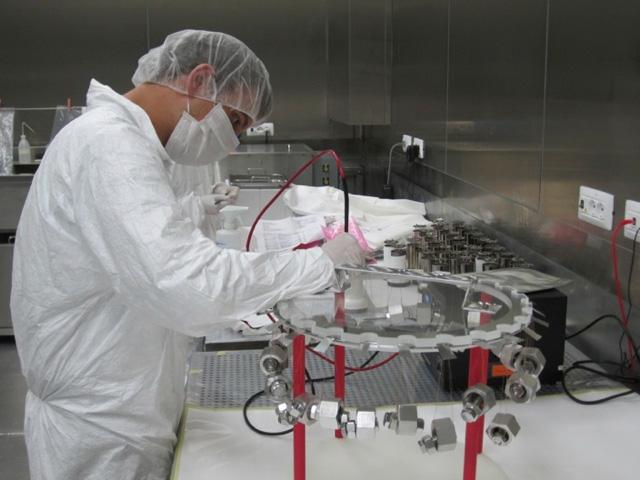UMass Amherst physicists contribute to dark matter detector success

Undergraduate Arthur Kurlej welding the grid electrode onto its support ring inside the radon-suppressed clean room in the underground laboratory at Gran Sasso, Italy. Kurlej's advisor, physics professor Andrea Pocar, says undergraduates were notably helpful in designing and making this component of the dark matter detector there, known as DarkSide-50. Credit: UMass Amherst
In researchers' quest for evidence of dark matter, physicist Andrea Pocar of the University of Massachusetts Amherst and his students have played an important role in designing and building a key part of the argon-based DarkSide-50 detector located underground in Italy's Gran Sasso National Laboratory.
This week, scientists from around the world who gathered at the University of California, Los Angeles, at the Dark Matter 2018 Symposium learned of new results in the search for evidence of the elusive material in Weakly Interacting Massive Particles (WIMPs) by the DarkSide-50 detector. WIMPs have been candidate dark matter particles for decades, but none have been found to date.
Pocar says the DarkSide detector has demonstrated the great potential of liquid argon technology in the search for so-called “heavy WIMPs,” those with mass of about 100 to 10,000 times the mass of a proton. Further, he adds, the double-phase argon technique used by the DarkSide-50 detector has unexpected power in the search for “low-mass WIMPs,” with only 1-10 times the mass of a proton.
He adds, “The component we made at UMass Amherst, with very dedicated undergraduates involved from the beginning, is working very well. It's exciting this week to see the first report of our success coming out at the symposium.” His graduate student Alissa Monte, who has studied surface and radon-related backgrounds using DarkSide-50, will present a poster at the UCLA meeting.
Pocar says, “There is a vibrant community of researchers around the world conducting competing experiments in this 'low mass' WIMP area. Over the past two years we collected data for a measurement we didn't expect to be able to make. At this point we are in a game we didn't think we could be in. We are reporting the high sensitivity we have achieved with the instrument, which is performing better than expected.” Sensitivity refers to the instrument's ability to distinguish between dark matter and background radiation.
Dark matter, Pocar explains, represents about 25 percent of the energy content of the universe and while it has mass that can be inferred from gravitational effects, physicists have great difficulty detecting and identifying it because it hardly interacts, if at all, with “regular” matter through other forces. “Dark matter doesn't seem to want to interact much at all with the matter we know about,” the physicist notes.
The DarkSide-50 detector uses 50 kg (about 110 lbs.) of liquid argon in a vat, with a small pocket of argon gas at the top, Pocar explains, as a target to detect WIMPs. The researchers hope for a WIMP to hit the nucleus of an argon atom in the tank, which then can be detected by the ionization produced by the nuclear recoil in the surrounding argon medium. Some of the ionization signal, proportional to the energy deposited inside the detector, is collected by applying an electric field to the target, he explains.
A flash of light is also produced in the argon with ionization, Pocar says. For high-enough energy events, the light pulse is bright enough to be used to tell the difference in “signature” between a nuclear recoil like that induced by a WIMP, and electron recoils induced by background or environmental radioactivity.
Pocar's lab designed, made and installed one of the electrodes that apply the electric field. He says, “For low-mass WIMPs, the amount of energy transmitted to the nucleus of argon by a WIMP is incredibly tiny. It's like hitting a billiard ball with a slow ping-pong ball. But a key thing for us is that now with two years of data, we have an exquisite understanding of our detector and we understand all non-WIMP events very well. Once you understand your detector, you can apply all that understanding in search mode, and plan for follow-up experiments.”
Cristiano Galbiati, spokesperson for the DarkSide project, said at this week's symposium, “This is the best way to start the adventure of the future experiment DarkSide-20k. The results of DarkSide-50 provide great confidence on our technological choices and on the ability to carry out a compelling discovery program for dark matter. If a detector technology will ever identify convincingly dark matter induced events, this will be it.”
###
The DarkSide-50 apparatus and experiments are supported by the Italian National Institute for Nuclear Physics, which operates the Gran Sasso Laboratory, the U.S. National Science Foundation, and funding agencies at collaborating institutions in Brazil, China, France, Poland, Spain and Russia.
Media Contact
All latest news from the category: Physics and Astronomy
This area deals with the fundamental laws and building blocks of nature and how they interact, the properties and the behavior of matter, and research into space and time and their structures.
innovations-report provides in-depth reports and articles on subjects such as astrophysics, laser technologies, nuclear, quantum, particle and solid-state physics, nanotechnologies, planetary research and findings (Mars, Venus) and developments related to the Hubble Telescope.
Newest articles

NASA: Mystery of life’s handedness deepens
The mystery of why life uses molecules with specific orientations has deepened with a NASA-funded discovery that RNA — a key molecule thought to have potentially held the instructions for…

What are the effects of historic lithium mining on water quality?
Study reveals low levels of common contaminants but high levels of other elements in waters associated with an abandoned lithium mine. Lithium ore and mining waste from a historic lithium…

Quantum-inspired design boosts efficiency of heat-to-electricity conversion
Rice engineers take unconventional route to improving thermophotovoltaic systems. Researchers at Rice University have found a new way to improve a key element of thermophotovoltaic (TPV) systems, which convert heat…



